Intel Core i7 3960X (Sandy Bridge E) Review: Keeping the High End Alive
by Anand Lal Shimpi on November 14, 2011 3:01 AM EST- Posted in
- CPUs
- Intel
- Core i7
- Sandy Bridge
- Sandy Bridge E
Gaming Performance
Most games have a tough enough time stressing more than four cores, so the move to the 3960X won't do much for gaming in most cases (particularly when GPU bound). That being said, the added cache may help give SNB-E a slight bump over its quad-core brethren.
Civilization V
Civ V's lateGameView benchmark presents us with two separate scores: average frame rate for the entire test as well as a no-render score that only looks at CPU performance.

In GPU bound scenarios the 3960X is no different than the 2600K. Civ V is a unique game in that its CPU workload does scale reasonable well across multiple cores:
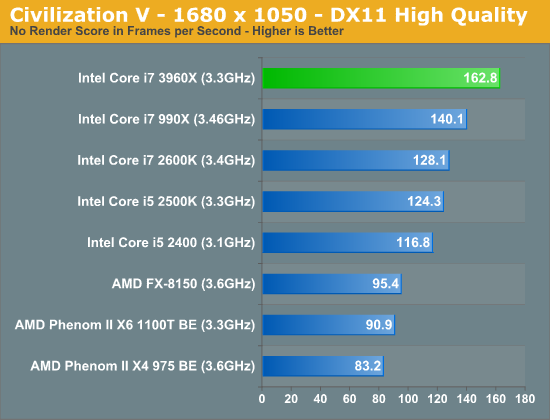
Here the 3960X is nearly 30% faster than the 2600K.
Crysis: Warhead
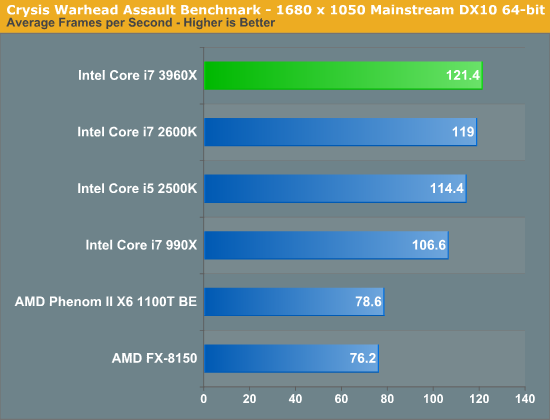
Dawn of War II
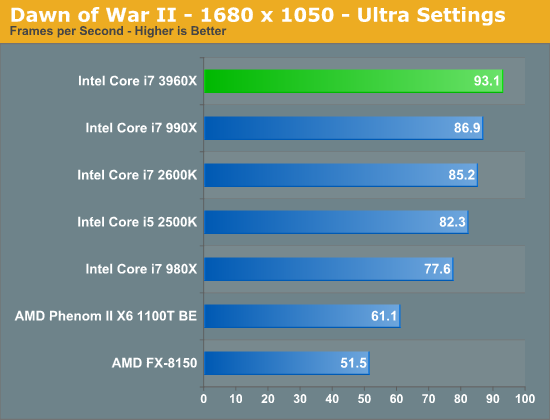
The larger cache helps give the 3960X a 9% advantage over the 2600K in Dawn of War II. At 1680 x 1050 the game isn't entirely GPU bound on our 5870.
DiRT 3
We ran two DiRT 3 benchmarks to get an idea for CPU bound and GPU bound performance. First the CPU bound settings:

DiRT 3 is an example of a CPU bound title (at lower resolutions) that doesn't scale well with core count or cache size. The 3960X is barely 2% faster than the 2600K.
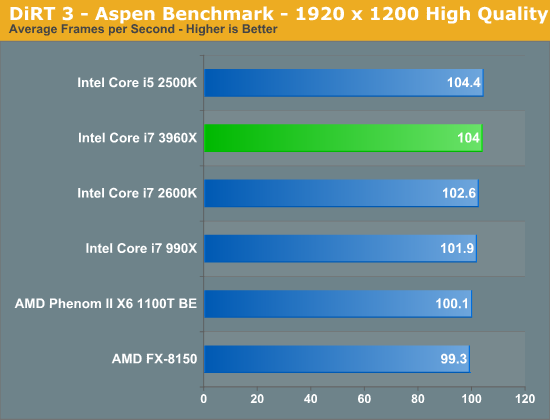
Metro 2033
It is interesting to note that while SNB-E and SNB perform similarly here, both parts do offer a performance improvement over the Gulftown based 990X.
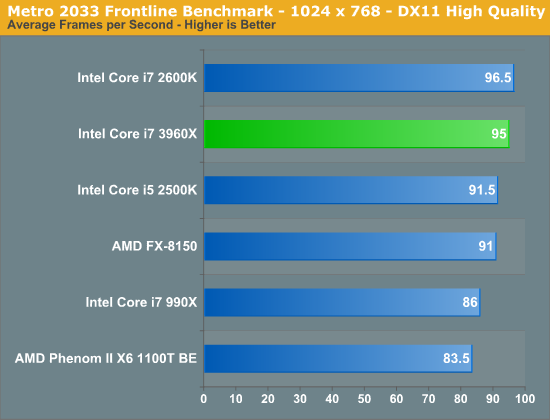
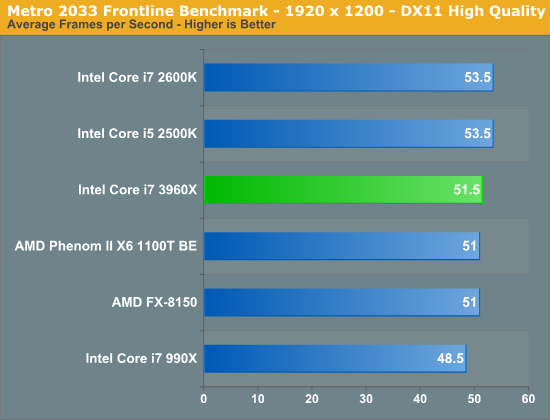
Rage vt_benchmark
While id's long awaited Rage title doesn't exactly have the best benchmarking abilities, there is one unique aspect of the game that we can test: Megatexture. Megatexture works by dynamically taking texture data from disk and constructing texture tiles for the engine to use (note that Rage doesn't store textures in a GPU-usable format). As a result whenever you load a texture, Rage is transcoding the texture on the fly. This is normally done by the CPU.
The Benchmark: vt_ are all the virtual texture commands. Vt_benchmark flushes the texture cache and then times how long it takes to transcode all the textures needed for the current scene, from 1 thread to X threads. Thus when you run vt_benchmark 8, for example, it will benchmark from 1 to 8 threads (the default appears to depend on the CPU you have). Since transcoding is done by the CPU this is a pure CPU benchmark. I present the best case transcode time at the maximum number of concurrent threads each CPU can handle:
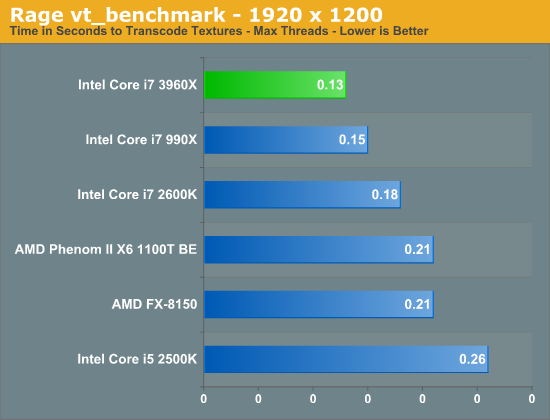
Starcraft 2
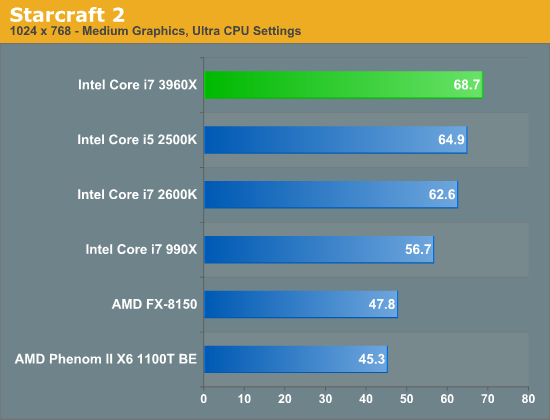
World of Warcraft
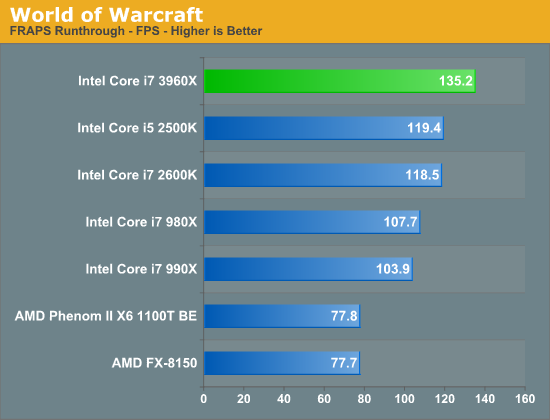
WoW does enjoy the 3960X's larger cache, here we see a 13% increase in performance compared to the regular Sandy Bridge parts.










163 Comments
View All Comments
Hauk - Monday, November 14, 2011 - link
Was hoping to get 40 PCI-E lanes & 2600K performance for $300.. craptastic that they delay the 3820 till next year. Can't wait any longer, 2600K it is..medi01 - Monday, November 14, 2011 - link
Hi,why don't we see AMD cpu pricing along Intel CPU pricing?
g00ey - Monday, November 14, 2011 - link
I think it is false advertising to call the Bulldozer 8C an eight core CPU. It doesn't really have eight cores, it's actually only four cores where they have added an extra ALU inside each core. It's like doubling the core count of the i7s because of the hyperthreading (SMT) feature. The addition of ALUs is nothing but an enhanced version of hyperthreading so a Bulldozer 8C is only 4 cores, 6C is only 3 cores and 4C is only 2 cores.But AMD say; No No No, there are two computation CORES inside each MODULE.
What a BIG WAD of *BULLSHIT*!!!!!!!!!!!!!!!!!!!!!!!!!!!!
They should be thrown into jail for such fraudulent statements!!!
raddude9 - Monday, November 14, 2011 - link
Nope Mr. Troll.Bulldozer 8C can run 8 threads simultaneously. Sandy Bridge E with it's 6 multi-threaded cores can only run 6 threads at the same time, the other 6 threads have to wait.
BSMonitor - Monday, November 14, 2011 - link
Actually you are completely wrong.Hyperthreading actually allows 12 threads to fully utilize the resources of a 6 core processor.
Whereby, Bulldozer simply has double the Integer hardware. Allowing it to run 8 integer threads simulateously. So long as there are that many consecutive integer computations in a row on each thread. Beware when floating point threads start to appear. And then it crawls back to 4 cores.
raddude9 - Monday, November 14, 2011 - link
What did I say that is wrong?Hyperthreading means that each core holds the state of 2 threads. Only one thread can run at a time, usually when one thread stalls, the other thread can kick in. So, at best it can run 6 threads at once, the 6 hyperthreaded threads are waiting in the backround for their chance. But it still just runs 6 threads at once.
You are trying to mislead people with your mis-information on the Bulldozer Floating Point unit. It's FPU can run as either two independent 128bit FPUs or a single 256bit FPU. So it can run two independent Floating Point instructions at once. So, Regardless of whether Bulldozer is running Floating Point or Integer instructions, it can still run 8 threads at once.
LittleMic - Tuesday, November 15, 2011 - link
You are wrong because you are describing T1000 and T2000 CPU and not Intel with HT. Sun processor are indeed hiding memory access latency this way.Intel processors are actually scheduling micro instruction from both threads according to execution resources availabitity. It is quite old technology now so the white papers have disappeared from Intel web site, but if you have a look at
http://en.wikipedia.org/wiki/Hyper-threading
the picture on the right clearly shows that a pipeline stage can contain µ instructions coming from 2 threads
LittleMic - Tuesday, November 15, 2011 - link
No edit...Finally found "official" paper directly from Intel :
http://download.intel.com/technology/itj/2002/volu...
Have a look at page 10 that shows that all the pipeline contains instructions from both threads simultanously.
Lord 666 - Monday, November 14, 2011 - link
Anand,Have read mixed information on the release date for the 26xx series Xeons with respect to release date and architecture. Actually holding off a much needed server because have read either December or Jan.
With the socket the same, is the reviewed SB-E the same design as the new Xeons? Will there be 3D design like Ivy Bridge?
Thanks - Loyal reader for over 7 years
mwarner1 - Monday, November 14, 2011 - link
I am impressed by how much memory you had in your 386SX! My first (IBM compatible) PC was a 486DX2-50 I bought for my Software Engineering degree and it only had 4MB. This was pretty much standard for the time.